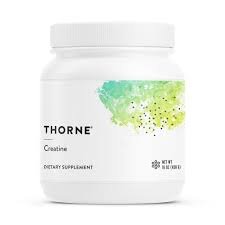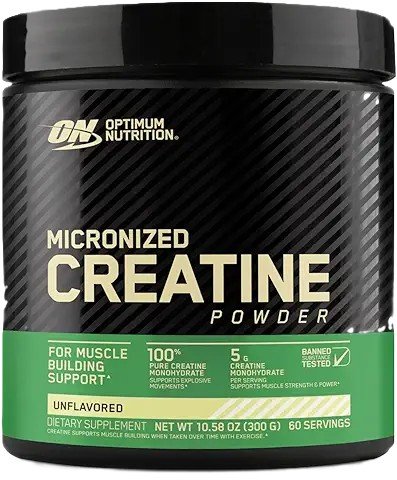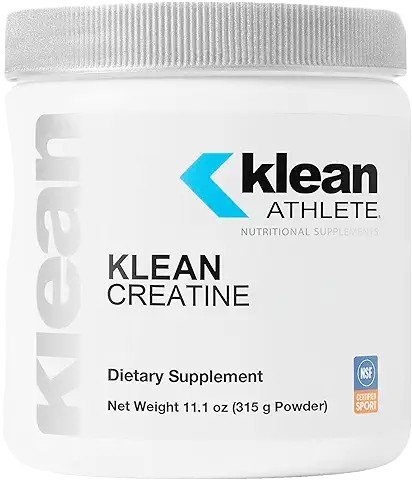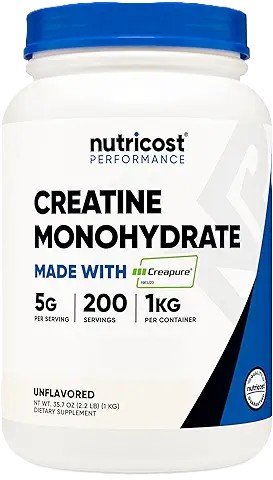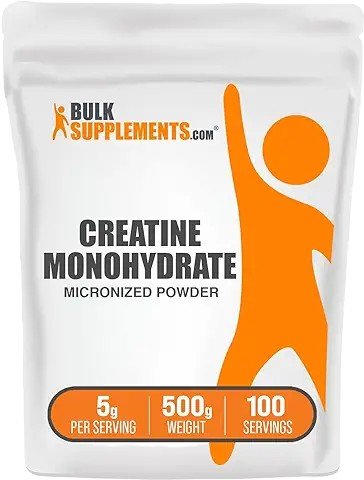THE CREATINE HYPE IS IT REAL
Creatine
what is it, and how can it help me?
I’ve been thinking about this since high school. I remember a good friend of mine taking it right after we graduated (25+ years ago). Back then, it almost seemed taboo, as if it were some illegal performance-enhancing substance. A few people in my core group of friends were using it, and you could definitely see the results, they were obviously getting bigger and stronger. But why was this happening? I chose not to take it at the time because, frankly, I didn’t care enough to research the topic. Plus, back then, it was much harder to “do the research” than it is today.
Fast forward 25 years, and now there’s ample information out there, plenty of efficacy studies and a proven safety record.
So, you might be wondering why I started thinking about creatine again. Well, it’s a bit of an indirect story. My wife was talking to me about perimenopause and how she thought she might be going through it. She’d been researching the topic and felt her symptoms aligned with what a perimenopausal woman might experience. After that conversation, I started getting perimenopause-related feeds on my Instagram account, wondering how that happened… As I watched a few videos, I came across one suggesting that women approaching perimenopausal age should consider creatine and explaining why. That sparked some thoughts, sending me down the creatine rabbit hole. I learned a lot about its benefits for perimenopausal women (more on that later) and started reading about the cognitive benefits one might gain from taking it, too. As a 48-year-old man who goes to the gym and tries to stay healthy, I wondered, should I give it a try? If so, what kind of creatine, and what are the differences?
This brings us to our first topic...
What is creatine?
Well, creatine is a naturally occurring compound found in small amounts in foods like red meat and seafood, and it’s also produced by the body (mainly in the liver, kidneys, and pancreas). It plays a critical role in energy production, especially during high-intensity, short-duration activities like weightlifting or sprinting.
In supplement form, creatine is one of the most researched and effective aids for improving athletic performance, strength, and muscle mass.
What are the Main benefits of Creatine
Creatine offers a wide range of well-documented benefits, especially for athletes, fitness enthusiasts, and even non-athletes. Here are the primary benefits:
- Helps to increase Strength and Power - Creatine enhances the body’s ability to rapidly produce ATP (energy), which improves performance in high-intensity, short-duration activities like weightlifting, sprinting, and explosive sports.
- Helps With Muscle Growth (Hypertrophy) - Supplementation leads to increased water content in muscle cells (cell volumization), which can stimulate muscle protein synthesis. Over time, this contributes to greater muscle mass gains when combined with resistance training.
- Helps to Improve Exercise Performance - Creatine helps you push harder in training by increasing your capacity for work and reducing fatigue. This means more reps, more sets, and better progress.
- Decreases Recovery Time - It may reduce muscle damage and inflammation, leading to quicker recovery between workouts or intense bouts of exercise.
- Cognitive Benefits - Emerging research suggests creatine may support brain health and cognitive function, especially in sleep-deprived or aging individuals. The brain also uses ATP, so creatine can help improve mental fatigue and clarity in some cases.
- Neuroprotective Properties - Creatine is being studied for its potential role in protecting against neurodegenerative diseases like Parkinson’s and ALS due to its support of cellular energy metabolism.
Since taking creatine, I’ve personally experienced almost all of the benefits mentioned above, but the two I’ve noticed most are strength and cognition. One thing I was worried about when starting creatine was becoming overly muscular and just looking bulky. That certainly hasn’t happened, but to my surprise, all the lifts I’m doing at the gym have significantly increased. From curls to leg lifts, they’re all up by at least 30%. As for the cognitive side, I’m a salesperson who spends a lot of time on calls. What I used to find is that by the end of the day, my words weren’t coming out the same way they did at 10 a.m. Since I started taking creatine, I’ve found myself much sharper at the end of the day than before. This was huge for me, not just for work but also for my family. When you’re zapped at the end of the day, it’s hard to give your family the attention they need and deserve. With the introduction of creatine, it helped me bring the energy I need to my wife and my 10- and 13-year-old boys.
Negative Side Effects of Creatine
What I Found About Creatine’s Real Side Effects:
Creatine’s pretty safe for most people, I’ve been taking it myself with no issue, but there are a few side effects that can pop up. Here’s what I’ve learned from the research and my own digging:
WATER RETENTION
- What Happens: Creatine pulls water into your muscles to help them work better, which can make you feel a little bloated or puffy, especially at first.
- How Common: Pretty common during the loading phase (20 g/day), less so with the regular 3–5 g/day dose.
- Proof: Studies, like the International Society of Sports Nutrition’s position stand (PMC), say it’s just water in muscles, not fat.
- This did not happen to me, but I also never went through a loading phase. I started with 5 grams a day and just stuck with it.
UPSET STOMACH
- What Happens: Some folks get a rumbly stomach, cramps, or even diarrhea if they take too much at once or don’t mix it well.
- How Common: Happens more with big doses or if you chug it on an empty stomach.
- Fix: I found dissolving it fully in water and sipping it with food helps a lot. Research backs this up, smaller, spread-out doses cut the risk.
KIDNEY STRESS (Only If You’re At Risk)
- What Happens: For healthy people like me, creatine doesn’t hurt kidneys. But if you’ve already got kidney problems, it might make things worse by adding extra work.
- How Common: Rare unless you’ve got a condition. I checked my labs after a few months, no issues here!
- Proof: A 2021 review (PubMed) found no kidney damage in healthy users, even after years, but cautions those with kidney disease.
DEYDRATION RISK (Mild)
- What Happens: Since creatine pulls water into muscles, you might feel thirsty or cramp up if you don’t drink enough. I’ve had to chug more water on workout days.
- How Common: Only if you slack on hydration.
- Proof: Studies say it’s not a big deal if you stay hydrated (PMC).
- This is something I did notice.
- I tend to drink a lot of coffee so making sure you have a little extra water with some Celtic salt will help with this issue.
Debunked Side Effects I Used to Worry About
There is a bunch of stuff I heard about creatine back in the day that freaked me out. As an example; it being dangerous or unnatural. Turns out, most of its nonsense. Here’s what I found out:
KIDNEY & LIVER DAMAGE
- The Myth: I used to think creatine trashed your kidneys or liver, like some steroid horror story. People said it’d overload your system.
- The Truth: Nope! Studies, like that 2021 revie (https://pubmed.ncbi.nlm.nih.gov/31375416/), show no harm in healthy people, even after 5+ years.
- My doctor laughed when I asked about this, he said it’s one of the safest supplements out there.
- Why It Started: Early worries came from mixing it up with steroids or rare cases where folks with bad kidneys got worse—not creatine’s fault.
HAIR LOSS
- The Myth: Hearing creatine could make us bald, something about it raising DHT (a hormone tied to hair loss).
- The Truth: Total myth for most. One tiny 2009 study (PubMed) saw a DHT bump in rugby players, but it didn’t prove hair loss, and no one’s replicated it since. I can’t personally speak to this because I’ve been hairless since my late 20’s.
- Why It Stuck: People love a scary story, but science says it’s not a thing.
MAKES YOU FAT
- The Myth: I thought creatine would pack on pounds and make me look chunky, not fit.
- The Truth: It’s just water weight in muscles, not fat. I have not gained any weight, and my waist’s the same. Studies (PMC) confirm its lean mass, not blubber.
- Why It Spread: Folks see the scale go up and panic, missing that it’s muscle fuel, not fluff.
CAUSES RAGE OR AGRESSION
- The Myth: You’re going to turn into a raging gym bro on creatine, like it’s some mood-altering drug.
- The Truth: No evidence at all. I’m still chill! It’s not a steroid, it just helps energy, not your temper. Research, like the cognitive studies (PubMed), even says it might calm you down by boosting brain power.
- Why It Started: Probably confusion with testosterone boosters or juiced-up gym stereotypes.
So, what are the different Types of Creatine?
Creatine Monohydrate
- What Is It: The original, simplest form, creatine + one water molecule.
- Purpose: Baseline standard; no frills, just effective.
- Absorption/Quantity: Highly bioavailable (near 100%), with 3–5 g/day saturating muscles in 2–4 weeks (or faster with loading).
- Why It’s “Enough”: Decades of research (e.g., Journal of the International Society of Sports Nutrition, PMC) show it consistently increases muscle creatine stores by 20–40%, boosting strength and performance.
Micronized Creatine Monohydrate
- What Is It: Monohydrate ground into finer particles.
- Purpose: Improves solubility and mixability, reducing grittiness.
- Absorption/Quantity: Same bioavailability as regular monohydrate, but better dissolution may enhance uptake slightly in practice. Dose remains 3–5 g/day.
- Evidence: No significant performance difference, but user comfort improves (less stomach upset for some).
Creatine Hydrochloride (HCl)
- What Is It: Creatine bonded with hydrochloric acid.
- Purpose: Increases solubility and stability in acidic environments (e.g., stomach), aiming to reduce creatine conversion and bloating.
- Absorption/Quantity: Claims suggest higher bioavailability, allowing smaller doses (1–2 g/day vs. 5 g). A 2010 study (Journal of Dietary Supplements) showed creatine HCl raised blood creatine levels effectively at lower doses in animals, but human data is limited.
- Reality: May reduce water retention for some, but no conclusive evidence it outperforms monohydrate in muscle saturation or strength gains.
Creatine Ethyl Ester (CEE)
- What Is It: Creatine with an ester group attached to enhance cell membrane permeability.
- Purpose: Aims for better absorption by bypassing stomach degradation and entering muscles more directly.
- Absorption/Quantity: Marketed as needing less (2–3 g/day), but studies (e.g., Journal of the International Society of Sports Nutrition, 2009, PubMed) found it less effective than monohydrate, more degrades to creatinine, reducing efficacy.
- Reality: Once hyped, now largely debunked as inferior due to instability.
Buffered Creatine (e.g., Kre-Alkalyn)
- What Is It: Creatine monohydrate buffered to a higher pH (less acidic).
- Purpose: Claims to resist conversion to creatinine in the stomach, improving absorption and reducing side effects.
- Absorption/Quantity: Suggested dose is lower (1.5–3 g/day), with promises of faster results. A 2012 study (Journal of the International Society of Sports Nutrition, https://pmc.ncbi.nlm.nih.gov/articles/PMC3479057/) found no significant difference in muscle creatine content or performance vs. monohydrate.
- Reality: Marketing-driven; benefits are marginal at best.
Creatine Magnesium Chelate
- What Is It: Creatine bound to magnesium.
- Purpose: Magnesium may enhance ATP production, potentially boosting creatine’s effects.
- Absorption/Quantity: Dose similar to monohydrate (3–5 g/day). A small study (Journal of Strength and Conditioning Research, 2003) suggested slightly better strength gains, but results aren’t widely replicated.
- Reality: Interesting concept, but evidence is thin compared to monohydrate.
Creatine Nitrate
- What Is It: Creatine combined with a nitrate group.
- Purpose: Nitrates improve blood flow, aiming for better muscle delivery and endurance.
- Absorption/Quantity: Claims higher solubility and dual benefits (creatine + vasodilation) at 3–5 g/day. Limited studies (e.g., Journal of the International Society of Sports Nutrition, 2014) show solubility advantages, but performance data is inconclusive.
- Reality: Niche appeal, but not a game-changer over monohydrate.
This is confusing...
Why are there so Many Types of Creatine?
isn’t creatine, well creatine?
Well, you’re right: at its core, creatine is creatine, a molecule that boosts energy by replenishing ATP in muscles and tissues. So why the variety? It’s not about changing the compound itself but optimizing how it’s delivered, absorbed, and experienced. Manufacturers tweak creatine monohydrate, the most researched, effective, and affordable form, to improve solubility, bioavailability, or user comfort, often addressing its perceived flaws.
Why all the different versions?
Creatine monohydrate, made of creatine bound to a water molecule, is stable and near-perfectly absorbed (95–99%).
But it has quirks:
- Solubility: It doesn’t fully dissolve, leaving sediment some find gritty.
- Absorption: A tiny fraction converts to creatinine in the stomach’s acid before reaching muscles.
- Side Effects: Some report bloating, especially during loading (20 g/day), though this is overstated.
- Dosing: The standard 3–5 g/day works, but lower doses or faster results appeal to users and marketers.
Newer forms adjust the structure or add compounds to enhance absorption, cut side effects like bloating, or reduce required amounts. Evidence of their superiority over Monohydrate, though, is shaky.
Bigger Picture
Absorption: Variants aim for better bioavailability or smaller doses via improved solubility or stability. Yet monohydrate’s high absorption leaves little to gain, muscle saturation is similar after a month.
Marketing vs. Science: New types tout theoretical perks (e.g., pH stability) and higher prices, but studies (e.g., PMC) keep monohydrate as the gold standard.
User Experience: Some (like HCl or micronized) mix better or ease bloating, mattering to users even if results don’t differ much.
2-Most Popular Types of Creatine
Creatine Monohydrate
vs.
Creatine HCL
Key Differences:
Creatine Monohydrate and Creatine Hydrochloride (HCL) are two popular forms of creatine, both aimed at enhancing strength, power, and performance. While both are effective, they differ in structure, dosage, absorption, and side effects.
Creatine Monohydrate is the most researched and widely used form of creatine. It has a well-established track record for improving muscle mass, strength, and exercise performance. It’s cost-effective and typically taken in doses of 3–5 grams per day. Some people report mild bloating or water retention, especially during the initial loading phase, though this varies.
Creatine HCL, on the other hand, is a newer form where creatine is bound with hydrochloride, making it more soluble in water. This improved solubility may enhance absorption and reduce stomach discomfort or bloating. Because of its higher absorption rate, HCL is taken in much smaller doses, typically 1–2 grams per day, making it easier on the digestive system for some individuals.
Why choose one over the other?
- Go with Creatine Monohydrate if you’re looking for a proven, affordable, and reliable supplement backed by decades of research. It’s ideal for most users, especially those who tolerate it well. Personally, this is where I would start for anyone who has never taken creatine before.
- Choose Creatine HCL if you experience bloating, cramping, or digestive discomfort with monohydrate, or if you prefer a smaller serving size and faster absorption.
In terms of effectiveness, both forms support similar performance outcomes. The choice ultimately depends on personal tolerance, convenience, and cost. If you’re unsure, trying monohydrate first is usually the best place to start due to its strong track record and affordability.
TOP 5 Creatine Monohydrate Supplements
Thorne Creatine
PROS:
- High Purity: Contains only micronized creatine monohydrate, free of additives, praised for its clean formulation.
- Excellent Solubility: Customers note it dissolves easily in water or other liquids, reducing grittiness.
- Trusted Certification: NSF Certified for Sport, ensuring safety and quality, especially for athletes.
CONS:
- Higher Price: More expensive than budget options (around $0.50–$0.70 per serving), which is more costly than most.
- Bitter Aftertaste: Some users report a slight bitterness or aftertaste when mixed with water alone.
- No Scoop Variety: Only offers a single serving size (5 g), limiting flexibility for those adjusting doses.
Optimum Nutrition Micronized Creatine Monohydrate
PROS:
- Cost-Effective: Affordable at around $0.33 per serving, making it accessible for consistent use.
- Micronized Formula: Fine powder mixes well, reducing clumping, as noted by many users.
- Brand Reputation: Widely trusted by gym-goers and athletes, with consistent quality across batches.
CONS:
- Settling Issue: I’ve noticed sediment at the bottom of the glass, requiring extra stirring.
- No Scoop Included: I did not have this issue but some reported occasional missing scoops, causing inconvenience.
- Mild Bloating: Users may experience initial water retention or bloating.
Klean Athlete Klean Creatine
PROS:
High-Quality, Pure Creatine Monohydrate: Users appreciate that the product contains only pure creatine monohydrate without any artificial additives, aligning with the brand’s commitment to clean and straightforward formulations.
NSF Certified for Sport: The supplement’s NSF Certified for Sport designation assures users of its safety and quality, making it a trusted choice among athletes concerned about banned substances.
Effective Performance Enhancement: Many users report noticeable improvements in muscle strength and workout performance after incorporating this creatine into their regimen.
CONS:
Mixability Issues: Some customers have noted that the powder can be challenging to mix, sometimes resulting in a chalky texture.
Higher Price Point: Compared to other creatine supplements, Klean Creatine is considered relatively expensive, which may be a drawback for budget-conscious consumers.
Packaging Concerns: There have been instances where customers received products with broken seals, particularly when ordering from third-party retailers, leading to recommendations to purchase directly from the Klean Athlete website.
Nutricost Creatine Monohydrate
PROS:
- Exceptional Value: One of the cheapest options at $0.25–$0.35 per serving, especially in bulk.
- Versatile Options: Available in flavored and unflavored versions, catering to different preferences.
- Third-Party Tested: The transparency and purity assurance are appreciated.
CONS:
- Flavor Complaints: Some flavored versions are criticized as too sweet or artificial.
- Mixability Issues: Unflavored version can settle or feel gritty if not mixed thoroughly.
- Packaging Concerns: Reports of tubs being hard to scoop from as product levels decrease.
BulkSupplements Creatine Monohydrate
PROS:
- Bulk Savings: Extremely cost-effective in large quantities (as low as $0.20 per serving).
- Pure Ingredient: 100% creatine monohydrate with no fillers, reviews praised for simplicity.
- Customizable Dosing: Sold in bags, allowing users to measure exact amounts.
CONS:
- No Scoop Provided: Lack of a scoop frustrates some, requiring separate measuring tools. I have many of these scoopers so this is not an issue for me.
- Packaging Durability: Resealable bags can tear or fail to seal properly
- Mixing Effort: Slightly less micronized than competitors, leading to occasional clumping.
Perimenopause
What Is It And Can Creatine Help
Perimenopause is this phase that happens before menopause, where hormones like estrogen and progesterone start fluctuating a lot. It typically begins in a woman’s 40s, though it can kick in earlier, and lasts until periods stop for good. It often brings hot flashes, mood swings, fatigue, and brain fog, basically, the body’s adjusting to a big shift. It varies for everyone, but that’s the gist of what’s going on!
With the permission of my wife Ive been digging deeper into whether creatine could help her with perimenopause. She was exhausted, muscles feel weaker, brain’s foggy, moods swing, and she’s worried about her bones. I heard creatine might fix some of that. There’s not much research just on perimenopause, but studies on other folks, like older women or healthy people, gave me some ideas. Here’s what I found and the proof to back it up.
How Creatine Might Help with Perimenopause
Stronger Muscles
Since perimenopause hit, my wife’s estrogen was dropping, and it’s shrinking her muscles. Creatine’s supposed to build strength and muscle, especially if paired with lifting weights.
- Proof: A 2021 study, “Creatine Supplementation in Women’s Health: A Lifespan Perspective,” says it boosts strength in younger women and helps older women grow muscle with higher doses (0.3 g/kg/day). It’s not exactly my phase, but it feels close enough.
More Energy
She’s also very tired these days, hormones and lousy sleep are dragging her down. Creatine makes energy (ATP) in your body, so it might give me a boost to keep up.
- Proof: That same 2021 study mentions creatine helps with energy, which sounds like a lifesaver.
Clearer Head and Better Mood
She felt her brain was a mess, forget things, and moods are up and down. It’s the estrogen drop messing with her, especially since she barely sleeps. Creatine might sharpen thinking and calm feelings.
- Proof: A 2018 study, “Effects of Creatine Supplementation on Cognitive Function of Healthy Individuals,” found it improves memory and thinking, especially when you’re worn out. It’s not perimenopause-specific, but it fits my fog.
- More Proof: A 2022 study, “Effects of Creatine Supplementation on Brain Function and Health,” says it lifts mood and focus when you’re sleep-deprived.
Stronger Bones
She was scared her bones were getting weak as her estrogen faded. Creatine, with some exercise, might keep them solid by easing inflammation and stress in my body.
- Proof: A 2023 study, “A 2-Year Randomized Controlled Trial on Creatine Supplementation during Exercise for Postmenopausal Bone Health,” showed creatine (0.14 g/kg/day) with workouts didn’t change bone density but strengthened leg bones. It’s for older women, but I’m heading that way.
Final Thoughts On Creatine and Perimenopause
Over the past 90 days, my wife has been taking creatine daily, and it’s been a game-changer for her perimenopausal symptoms. She started with a simple 5-gram dose mixed with water, hoping to tackle the fatigue and muscle weakness that had been dragging her down as her hormones shifted. Within a few weeks, she noticed she wasn’t as wiped out after her day, whether it was chasing our kids or just managing her day-to-day activities. Her strength came back too. That boost in energy and muscle power has her feeling more like herself again, despite the ups and downs of perimenopause.
Beyond the physical perks, creatine’s helped her brain and mood, which were really taking a hit. She used to complain about brain fog, like forgetting where she parked the car, and mood swings that left her snappy one minute and teary the next. After about a month on creatine, she started saying her head felt clearer, like she could focus better. The mood swings haven’t vanished, but they’re less intense, she’s been more even keeled, which has been a relief for her and honestly for the whole family. It’s not a cure-all, but these past 90 days show creatine’s giving her a solid edge against those perimenopausal curveballs.
Can Kids Benefit from Creatine?
I think kids might get some real perks from creatine, and there’s evidence to back that up. Studies have looked at how it affects children’s growth, recovery from concussions, and brain development. Here’s what I found, made simple, with links to the studies for proof
Does Creatine Help Kids Grow?
There’s not a ton of research on how creatine affects kids’ growth, like their height or weight, but a few studies give us clues. One big study, “Relationship between Dietary Creatine and Growth Indicators in Children and Adolescents Aged 2–19 Years,” checked out data from the 2001–2002 National Health and Nutrition Examination Survey (NHANES). It found:
- Kids eating more creatine from food (like meat), at least 1.5 g a day, were taller, heavier, and had higher BMI than kids eating less.
- Every extra 0.1 g of creatine per day added about 0.3–0.6 cm to their height, depending on how you crunch the numbers.
This hints that creatine from food might help kids grow, but it doesn’t tell us about supplements. Check it out here: https://pubmed.ncbi.nlm.nih.gov/33806719/
Can Creatine Boost Kids’ Brains?
There’s not much on creatine helping healthy kids’ brains grow, since most studies focus on adults or sick kids. But here’s what I dug up:
- A study on kids with brain injuries, “Prevention of Complications Related to Traumatic Brain Injury in Children and Adolescents with Creatine Administration,” showed creatine improved their thinking skills after a concussion. It suggests creatine might help brains under stress. See it here:
- Kids born with rare creatine shortages in their bodies have big brain problems, but high-dose creatine can help them think better. This shows creatine matters for brain growth, though it’s only for those special cases. Read more:
- For healthy kids, there’s no big proof yet. Adult studies, like “Effects of Creatine Supplementation on Cognitive Function of Healthy Individuals,” show it boosts memory and smarts, but kids weren’t included. Here’s that one:
Final Take on Creatine & Kids
Creatine looks promising for kids, maybe for growing taller or stronger, definitely for concussion recovery, and possibly for brain power in tough situations. We need more studies on healthy kids, but what’s out there makes me think it could be a win. These studies are my proof, and they’re a good place to start!
Can Creatine support Concussion recovery?
When I first heard about creatine and concussions, I was curious, could this stuff I take for the gym really help a person’s brain after a hit. Turns out, there’s some solid science behind it. Creatine, that powdery supplement known for boosting muscle energy, might also protect and repair the brain after a concussion. Concussions happen a lot, especially in kids playing sports or adults in accidents, and they can leave you foggy, tired, or worse if not handled right. Research suggests creatine could step in by fueling brain cells, cutting inflammation, and speeding recovery, which got me thinking about its potential beyond just lifting weights. Here’s how it might help with concussions, based on what I’ve dug up.
Supports Cellular Energy in the Brain
Concussions disrupt normal brain metabolism, especially ATP (energy) production. Creatine helps restore ATP levels by acting as a quick energy reserve in the brain. This support can help brain cells function better during the recovery period.
Neuroprotection
Creatine may protect neurons from damage by stabilizing cell membranes, reducing oxidative stress, and preventing excitotoxicity (a harmful overactivation of brain cells after injury). These effects can reduce the extent of brain damage after a concussion.
Speeds Up Recovery
Some studies in animals and early human trials suggest that creatine can reduce the duration and severity of post-concussion symptoms, such as:
- Brain fog
- Headaches
- Fatigue
- Memory issues
Promising Pediatric Research
In a small study on children with traumatic brain injury, creatine supplementation significantly reduced symptoms like dizziness, fatigue, and headaches, and improved functional recovery.
Important Notes:
- While early research is promising, creatine is not a cure for concussions.
- Most studies are in animals or small human trials. More large-scale research is needed.
- Creatine may be more effective when taken regularly before a concussion occurs (e.g., athletes in contact sports), but could also be beneficial for post-injury.
Joe's Creatine Conclusion
YES, THE HYPE IS REAL – There’s a ton of information out there, and more keeps pouring in every day. Whether you’re an athlete chasing peak performance, an average Joe like me, or a woman starting her perimenopause journey, creatine has proven, time and again, to offer tremendous benefits. I started mixing drinks for myself, my wife, and my older son, who’d had a concussion, after discovering these perks. We’ve noticed better overall performance, not just athletically, but in quality of life. We’re thinking clearer, recovering from workouts faster, and adding a bit of muscle. My wife even crushed it at a master’s track-and-field pentathlon, beating competitors that she never thought she would or could a few months ago. I’m not saying it’s right for everyone, we’re all unique – but I want to hammer this home: creatine isn’t just for athletes or concussion recovery. It’s for anyone wanting to age gracefully, stay sharp, and keep moving, no matter what their goals or stage of life.

